Yuma County, Colorado
Photographs

Yuma County, Colorado |
 |
| Home Page | Photograph Index | Site Index |
In 1880 Rawlins County Kansas Thomas is 40, Mary Ann is 26. They have S.E. 7, J.C. 6, E.G. 4, August 2, and B.H. five months.
John Cowger, born about 1815 in Highland County Ohio, died in 1886 and was buried at Bonny. He was relocated to the Armel cemetery when the reservoir was constructed. One tree said he had married Elizabeth Ann Caldwell July7, 1837 in Rush County Indiana, and she died there in 1842.
In 1895 Jaqua, Cheyenne County, Kansas T.C. is 54, M. A. 40, J.C. 21, Alonzo 19, Aug 17, Robert H. 15, Pearle 12, G.A. 8, and S. M. 4.
Township map of Jaqua, Cheyenne County, Kansas shows T. C. Cowger with 2 plots of 240 acres each, Mary A. Cowger 160 acres, August Cowger 80 acres, J.C. & Alonzo 'Lon' Cowger with 2 plots of 160 acres each and J. C. Cowger 1 plot of 40 acres on the Kansas-Colorado border.
John and "Tacum" (Alonzo Theodore) are living together in 1900 Jaqua, Kansas.
1900 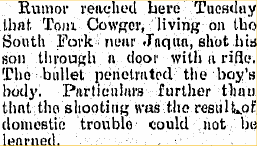
1903 Mrs. Sarah Palmer was among those taking the county examination. (for school teachers), and she attended the Wray Normal that year.
1904 Sarah, "of Jaqua Kan" was a witness for the proving up of Richard H. Coston
April 1904 "Wedding bells were ringing Tuesday nearly all day. Robert Cowger was the young man from Haigler and the young lady was from near Jaqua. We have not learned her name but will give it when the cards are out."
One tree says she was Roseannie Elizabeth Stothard born Dec 13, 1876 in Putnam County Missouri, dying June 1973 in Upton, Weston County, Wyoming.
In 1910 Robert H. Cowger 30, is in Jaqua, Cheyenne County, Kansas, married to Rosy E. 33. They have Margarett E. 4, Robert E. 2, and Wilber S. 1.
Robert Henry Cowger registered for WWI in Newcastle, Wyoming, saying he was born Jan 11, 1880, and was married to Rosana Elisabeth Cowger.
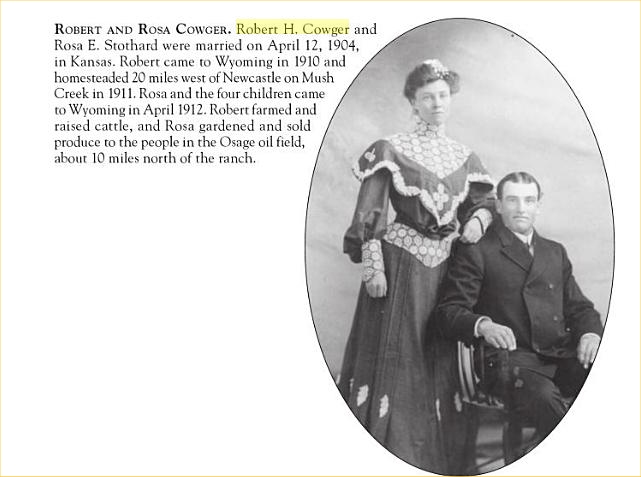
Robert H. Cowger died Dec 15, 1930 in Fall River County, South Dakota, and Rosa is in Weston County in 1930, with Elizabeth 17, John H. 12, and Hope 9.
She's widowed in 1940 Weston County, and granddaughter Elizabeth N. Hosman, 13 is with her.
| Services for Weston County native S. Hope Smallwood, 72, were held
Tuesday, April 20, 1993, at 2 p.m. at Worden Funeral Chapel by Pastor Al
Simms of the Newcastle Southern Baptist Church. Interment followed at
the Newcastle Greenwood Cemetery. Smallwood died Thursday, April 15, 1993, at Weston Manor following a lengthy illness. She was born March 29, 1921, in Weston County to homesteading pioneers, Robert and Rosa (Southard) Cowger. She was reared in Weston County and attended country schools and Newcastle High School. In 1939, she married John W. Martens and they ranched on Beaver Creek. He preceded her in death. In 1958, she married Coral "Brownie" Smallwood, who also preceded her in death. They lived in Texas until the early 1960s, at which time they returned to Weston County, where she was employed as a bookkeeper. The couple owned and operated a restaurant in Upton, and managed the Michael's Senior Center for a number of years. Smallwood enjoyed horses and fishing with her husband. She was a member of the Order of Eastern Star in Douglas. She is survived by one son, John Elliott Martens of Santa Rosa, Calif., two step-sons, Larry of Oroville, Calif. and Jim Smallwood of Biggs, Calif., one brother, Bronco Cowger of Thermopolis; one sister, Bessie Popham of Newcastle; five grandchildren and one great-grandchild. In addition to her husbands, she was preceded in death by her parents, three brothers and one sister. |
Sarah proved up a quarter in 5, 5S 42W in 1905.
John C. Cowger proved up land in sec 20, 5S 42W in 1910
1909 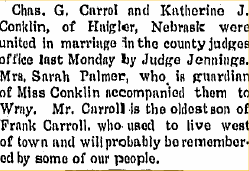
Martin Luther Hannaford married Sarah( Susanne) Palmer January 17, 1895. Sarah Palmer was married before Martin to William Hodgkinson. They had one daughter Zoe married Bill Beason, and John Hayes.(I think Zoe lived in Nemaha Co. but I am not sure). Blanche I think moved to Yuma County Colorado, I live not far from Yuma Co. but have yet to take the time to research anything. Just not enough time in the day. Nellie Fern, I have nothing on her and of course John W. lived on his father's farm until he passed away. William M, (Martin's father) was a farmer then Martin Luther took over the acreage, then John W. took over the same farm and then John's son Dwaine continued the farming. Dwaine has several boys and they are still farming the same place William farmed. As far as your relative Sarah Palmer, I have a newspaper clipping that stated she was born in Smithfield Idaho. (sic Utah) [Grace Russell] Sarah Palmer Hodgkinson Hannaford, who was the daughter of John Palmer, from Rosemary Braun. I had assumed Sarah's first husband died, but Rosemary tells me they were divorced. She says: William Hodgkinson was my grandmother's uncle! I even knew him as I was growing up for he did not die in 1891-95. As a matter of fact, he married two more times as he and Sarah were divorced. Here are a few details for now: William Wakefield Hodgkinson was born 4 Jul 1869 London, Nemaha, NE to George and Harriet Hodgkinson. He married Sarah (I have Susanna as the middle name - ??)Palmer 23 Dec 1889 NE. Their daughter, Zoe Elizabeth was born c1891. I have Auburn, Nemaha, NE as the place. I have only sketchy information for Zoe, that she married (1) _____ Hayes and (2) _____ Beason.
I, Kathryn, have corresponded several times with Rosemary Braun and she emailed me a photo of William, but she doesn't have a picture of Sarah or their daughter Zoe. (from KJC)
189?: Sarah Elizabeth Palmer (m. abt 1890) William Hodgkinson
Children:
Zoe Elizabeth Hodgkinson (b. 14 Jan 1891) (m.) Bill Beason (h1), John Hayes (h2)
1895: Sarah E. Palmer Hodgkinson (m. abt 1895) Martin Luther Hannaford (aka Lute)
Children:
Blanche M Hannaford (b. Apr 1896); moved to Yuma, CO.
John William Hannaford (b. 8 Nov 1897)
Children:
Dwaine Hannaford
Children:
Several sons
Ref: Grace Russell email to KJC1868: Alice M. Palmer ( b. 18 Feb. 1868) to John/Mary Palmer in Smithfield, UT.
Ref: 1870 NE Census, Nemaha Co. Peru Pct. Roll 731, pg 20.
Ref: 1880 NE Census, Nemaha Co. Peru Pct. Roll 752-753, pg. 98.
Ref: California's death index (1940-1997) on line 6/5/2000. [verified by KJC]
In 1900 Lansing Sarah E. Browning, 27 divorced, has Addie May 1894 and Dudley Sep 1895, both Colorado.
In 1910 Haigler, Nebraska Todd Palmer 43, has been married seven years to Sarah, 37. They have Emma 4 and Edna 4 both born Nebraska.
In 1920 Ernest M Palmer 53 and Sarah E. 47 are in Sevier County Arkansas, with Edna and Emma.
A caption for the 1933 family reunion photo mentions Emma (Palmer) Crouch, Sarah E. (Cowger) Palmer, and Edna Palmer
In 1930 Lincoln County Oklahoma Sarah is widowed, teaching in a public school. Edna and Edna are in Seminole, Oklahoma, both teaching.
Thomas Cather COWGER was born on 16 Sep 1840 in Rushville, Rush County, IN. CENSUS in
1850 at Age - 10 - Wayne, Marion County, Indiana. CENSUS in 1854 at Age - 13 - Dallas County, IA
- no image. CENSUS in 1860 at Age - 20 - Not with fathers family in Dallas County, IA. Between
1860 and 1917 he worked as Farmer/Freighter/Teamster/Stock Trader in Nebraska, Kansas and
Colorado. CENSUS in 1870 at Age - 30 - Lincoln, Lancaster County, NE - living with Becker family. Married Mary Ann Becker 1854-1936
CENSUS in 1880 at Age - 40 - Stock dealer - Rawlins County, KS. Homesteaded in 1883 in Cheyenne
County, KS CENSUS in 1890 at Kansas records unavailable. He Letter from son John Carl Cowger
about Thomas shooting Lon with Colt45 on 7 Mar 1900 in Jaqua, Cheyenne County, KS. CENSUS
on 20 Jun 1900 at Age - 60 - Farmer-Cheyenne County; Jaqua, KS. DIED of Chronic valvular heart
disease on 4 Sep 1917 in Denver, CO. BURIAL on 9 Sep 1917 in Riverside Cemetery, Denver, CO;
Robert Henry Cowger b. Jan 11, 1880 Rawlins County, Kansas m.1904 in Jaqua,
Cheyenne County, Kansas d. Dec 15,1930 Hot Springs, SD
Rosa Elizabeth Stothard b. Dec 1884 Missouri d. Jun 8, 1973 Newcastle, WY
Robert and Rosa Cowger had 7 children (3 girls,4 boys)
| The following lengthy account was provided to me by Fern Hately,
John and Alice's grand-daughter in the late 1990's. John was born the third of nine children, the oldest of who was born, not only while the parents were crossing the plains, but also wandering around, trying to decide where to settle. Thomas met Mary in Nebraska and there they were married in 1870. I believe she was only 16 at the time. The first child, Charles, died as a baby. All of the other children except Pearl who was born in Red Willow, Nebraska, were born in Kansas and I know thatís where they grew up, John being the oldest boy. He was a red head and grew up to be a big man, 6 feet tall and weighed about 200 pounds, but was bald by the time he was 21. He taught me to count to ten in German when I was quite small but he really didnít have too much to do with us kids. I think he mostly didnít know what to do with us However, Rolla, Aunt Pearlís oldest girl, told me that she loved to go to Uncle Johnís and Aunt Mayís to visit. When John was young, the family lived out on the prairie and I have no idea how far from town or what town it was. Their father was a teamster, freighter, and/or scout for the wagon trains crossing the country at that time...again, I donít know from where or to where, but this did leave his wife with small children in the middle of nowhere. His mother, Mary, never knew when her husband would be home, if ever. Iíve never seen a picture of the house but I know that at one time it just had a blanket for a door so it probably was a sod house. Iíd hate to think of what winters were like. One time when Johnís father had been gone for a long time, Mary was down to the last of the flour and used it to baked bread. Just about the time the bread was done, she looked out and saw a group of Indians approaching. There were men, women and children with horses and travois . She wasnít afraid of them other than she knew they would smell the bread and would eat it all, she had no idea when Thomas would be back from his this trip and she would be unable to replace the flour. However, she did come up with an idea. Sure enough. The Indians headed straight for the house. She pulled back the blanket that served as a door and put one child on either side back far enough from the door that they couldnít have been seen from the outside. Then she took a broom and had them hold it across the doorway. (Probably Sarah and John as they were the oldest and probably the biggest). The Indians of course came to the door and it was obvious to Mary that they wanted her fresh bread. Then she indicated (I donít know how) that there was a spirit holding up that broom and that anyone that came in while it was there would die and somehow made them believe this. The Indians left and a couple of days later Thomas returned. One of the amazing things about this was Mary probably spoke very little if any English at that time, having grown up in a German home. I have been told she didnít learn English until her kids went to school. Of course I donít know how old any of them were at the time. I always thought they were living in northwestern Kansas but have heard that Aunt Margaret, Johnís youngest sister, said they were living in Nebraska. I think she heard the story told, just as I did, when she was a little girl. I doubt if she was born yet as she was the youngest child. She was born in 1891 at Jaqua, Kansas, and I donít think they lived out on the prairie at that time or any time after that. However, it could have been in either Kansas or Nebraska. One time Thomas brought home pocket knives for the boys when he came home and that was a real treat. He could be ornery and even mean to the older kids (and his wife). One time when they were still living away from town a neighbor stopped by and said they were going to the circus, I assume in St. Francis, and asked if the boys could go with them. Their dad said they could but when they got there they found out that it cost money and they didnít have any and the neighbors didnít have enough for them so they didnít get to see the performance. When they got home Thomas asked them how they liked it and the told him they did not get to see what went on in the tent because they didnít have any money. He told them he knew that but he had only told them they could go, not that he was giving them any money. The summer that Grandpa was 13 he and Uncle Lon was 11, they took a herd of cattle from western Kansas up to South Park in the mountains of Colorado and herded them all summer and then took them back home in the fall. I think the trip was about 200 miles one way. I never heard that they had any trouble. Boys were much more liable, and even expected, to do things like that back then. That would have been about 1887. The Alaskan Gold Rush started in the 1880s, ended in 1916, and Grandpa and his brothers, Lon, August and Robert, all went to Washington State intending to go to Alaska. However, when they got there, they found that Canada would not let them in unless they had money and/or supplies for a least six months and they didnít even have money to go by boat. That ended the Alaskan adventure. For years I never knew why they changed their minds and then read about this Canadian requirement and am sure this is why they didnít get up there. Canada had evidently had too many U.S. men that ran out of money and had no way to get home. Grandpa and Uncle Lon played baseball at one time. I think it was before Grandpa was married as I never heard Grandma say she ever saw him play. There was a picture of the two of them wearing baseball hats and some kind of uniform and wearing some kind of gloves, looking like regular leather gloves, not the ball gloves used today. I donít know what happened to the picture but imagine it got thrown away by someone who didnít know who they were. His sons as well as some of his grandsons and even great grandsons have followed in those footsteps. And yes, some of the girls have also played. (New Information: On Karenís last trip to Kansas she found a little book about Jaqua. In it is a picture of the Jaqua baseball team dressed as I describe. She also found out that Grandpa played the bass drum in the Jaqua band. I donít know when or why Grandpa became a blacksmith but he was one before he and Grandmas were married. In fact his shop was close to the store Grandmaís foster parents had and thatís probably how they got to know each other. His mother, dad, and brothers, as well as he, all had land, anywhere from 40 acres to 240 acres and most of the boys had more than one piece around Jaqua. Grandpa had forty acres right on the Colorado-Kansas line and he and Uncle Lon together had two parcels of 150 acres each. Their brothers, August and Rob each had one parcel. This information is from the 1907 Cheyenne County atlas. Eventually all of Thomasís family left the Jaqua area. Mary, Thomasís wife, moved to Denver, bought property on Elm and lived out her life there but she and Thomas never lived together again. This would have been between 1900 and 1910 according to the census records Karen has. They split the money they got for their land in Kansas (they each had land in their names but Thomasí was larger), she bought her in property in east Denver and still had money to live on until her death in 1936. Pearl, Margaret and probably Grace were with her when she moved there. After Charles and Monroe were born, Grandpa and Grandma homesteaded in Colorado right on the Kansas state line getting their mail at the Kanorado post office in Kansas. They proved up on their claim in 1914 and as far as I know that is the only time Grandpa farmed. Merle was born on the homestead in 1911. Grandma got sick there and the doctor thought she had tuberculosis so they moved by covered wagon to the Denver area in 1915, living several different places. She didnít have TB but I have never heard what she did have. Ed was born while they lived in Englewood in 1917 and Grandpa always made his living black smithing. (Information about where they lived is in the history Grandma wrote years later in 1949. They lived in Englewood at least twice and also in Denver. Oh, by the way. Grandpa was a jealous man. When they were living in Englewood, Grandma had gone to church one Sunday evening and a man walked her home because it was after dark. There was such a ruckus over this that Grandma quit going to church on Sunday nights. Eventually they moved to the Bancroft area, living in two or three places and Grandpa bought a blacksmith shop at the Curve (Wadsworth and the Morrison Rd. now only Wadsworth didnít go north of the Morrison Rd. at that time). There was a small lake near the shop and this shop was where Grandpa was so rough on Charles and Monroe. I mentioned this in the piece about Grandma, how he beat them for their mistakes when helping him and how differently they reacted. I donít think they could have been more than early teens at this time. Fortunately, Merle and Ed never had to go through this. Later, in 1927, he built the shop further out on the Morrison Rd west of present day Kipling Blvd, north of the north side of the Morrison Rd. This is the one I remember and it was his last. That is the first place they lived that I have any memories of. They lived in a large lean-to (probably 36 x 24 ft) attached to the shop but that was built a little later as they were living in Kelseysí big house when I was born as my folks lived with them there. (The Kelseys had the big house which was pretty nice as I remember from visiting there later, the slab house where Grandpa and Grandma lived three different times, and then another very plain house where Kelseys lived.) By the time they moved into the lean-to Jack and Ed were the only boys at home. It sure wasnít a fancy place and I imagine Grandpa always meant to finish it up better but that never happened. Sometime after the automobile came into common use Grandpa took a course in auto mechanics. This was in 1914 at the Sweeney Automobile School in Kansas City, Missouri. In 1914. (I couldnít find my copy of the certificate but Karen found hers and gave me the date.) Grandpa serviced the Bear Creek School buses as well as drove them and was still a blacksmith. He also worked on cars and had a gasoline pump out in front. There was a little one room building just to the west of the shop where Jack and Alma lived when Norma was born in 1933. No running water and no electricity. That wasnít too unusual at that time: many people still lived that way. It was also the Great Depression. Yes, it was really hard for many adults raising a family but us kids never thought about it , or at least I didnít. Earlier, just before the depression struck, Grandpa had invested in stock in Crown Hill Cemetery which was being built at that time. After the depression hit, it went broke and of course the stock did come back but Grandpa was one of many who lost more than they could afford. Grandma almost never criticized him but she told me that he was just trying to get rich quick. Anyhow, thatís what caused them to leave the shop. They moved first to the Autavat place and then to the Cykler place. It was while they were living there that I finally got to know Grandpa a little bit. I was about 12 years old and we would talk some. That is, he started talking to me some and I really enjoyed that. Grandmaís father, Grandpa Bud, lived with them while they were living there. I can never remember hearing Grandpa Bud says anything and I think maybe he was getting senile. (New information: Duane, son of Monroe, says he saw Grandma and Grandpa Bud talk but very quietly.) Once on the day he was to get his Old Age Pension check . he was sitting out on the front porch of the Cykler place, Grandpa Cowger was out in back chopping wood and Grandma came hurrying out to tell Grandpa Cowger that the Gypsies were coming down the lane to the house. Gypsies still traveled around at that time and evidently were known for conning some older people out of their pension checks. Grandpa Cowger didnít even lay his ax down, just walked around the corner of the house about the same time the Gypsies got to the steps of the front porch. They took one look at Grandpa with his ax and left in a big hurry. Grandpa Cowger wouldnít have hurt them but he must have made a pretty impressive sight. He still drove school bus until he had a little stroke or something similar, then worked for the WPA until he turned 65 which was the mandatory retirement age. After that he really didnít have much to do. He kept the weeds chopped down along the lane down from the slab house to the Morrison Road and he would go walking in the hills. The summer that Clarence, Jon and I stayed with them he and Jon, who was three at the time, would sit out on the front porch and count the cars going by on the Morrison Road. However, his mind wasnít as sharp as it had been and there were times when Grandma had to go out in the hills and look for him. At least when I was there he never went too far, and though he didnít know it, he was lost. He still chopped the wood and brought it in. And he could keep us kids in line. All he had to do was speak to us and we changed our ways. At mealtime, Jon would sometimes swing his legs as he was so little his feet didnít touch the floor. Somehow Grandpa would know he was doing it and would thump Jon on the head and tell him to sit still. Jonnie wasnít making any noise but Grandpa could tell. He and Jon were pretty good buddies. He still worked on his car, a Model T, or tried to and Grandma helped him. There were times when Grandma knew he was doing it wrong and it took a lot of her persuasion to get him to do it right. In the summer of 1943 they moved to the basement house on West Mississippi and lived there until 1945. This house was probably supposed to be the basement for a new house but had been finished as living space. Grandpaís mind was getting worse and in late 1943 or early 1944, Grandmaís ulcers got very bad again. Jack or Ed would go over every morning and night to get Grandpa dressed for the day and then at night, ready for bed . I donít know if Monroe went because they were living clear over on the other side of town. Anyhow, for three weekends I went over there on Friday night and stayed until Sunday...mainly to fix meals. Grandma stayed on the couch. Grandpa and I ate together. He was to the point then that when he sat down at the table he didnít know what to do so I would hand him a fork or whatever and then he knew. When I gave him the salt one day he said, ďDo you know where salt comes from? Well, it comes from the Great Salt Lake. My brothers and I were there once and the salt was just floating in the water in big chunks. Men would go in with ice tongs to grab the pieces and bring them to shore.Ē Another time we had the radio on listening to the news and most of that was about the war and the Japanese and their atrocities. Grandpa said, ďThose Japs worked on the railroad down in Kansas and they always were sneaky little devils.Ē Of course he was remembering the Chinese workers and I doubt if they were sneaky. He didnít know who I was but he liked me. Grandma would tell him I was Charlesí daughter but he couldnít remember that. He would ask where that nice girl was once in a while. Grandma got worse and had to go to the hospital in an ambulance. He evidently thought it was a hearse and that Grandma had died because from then on he would occasionally ask her who she was. She would say, ďJohn, Iím May.Ē and he would say, ďMy wifeís name was May but she died.Ē He was never mean to her or anybody else except for his older sister, Sarah. He didnít know who she was either but he knew he didnít like her. Once he wedged himself between the organ and the wall and couldnít get out. Grandma had to move the organ. He also started having fainting spells or little strokes, would fall and couldnít get up. Grandma couldnít really manage him by herself and her doctor strongly suggested she admit him to the State mental hospital in Pueblo. There were no nursing homes at that time so pueblo was the only choice. It was a hard decision but necessary and Monroe, Jack and Ed all agreed (Charles was living in California and so was not consulted but he would have agreed too.) Grandma went down to Pueblo as often as she could, sometimes getting a ride and sometimes riding the bus. He was always clean and shaved. He had that very tender skin that sometimes goes with red hair and Grandma said they must be very good at shaving him because he could really get upset with having it done by her. I donít know how much schooling he had but he had beautiful hand writing. That is, his signature was beautiful. Iíve seen it in his bible and in his autograph book. He was a hard worker all his life even if some of it was ďmake workĒ at the end. I think he treated his children, or at least his boys, as he thought best and may never have had any way to learn about kids. And I really think he liked his grandchildren. After all, he did feed me part of a hot dog when I was still a baby. My mother was afraid of him and just knew I was going to die. You know, I always have liked hot dogs. I wish I knew more about him. He was a hard worker, loved Grandma, was close to his brothers and most sister, was a good blacksmith and auto mechanic. He and his sister, Aunt Sarah never seemed to get along but Aunt Sarah was a domineering woman and was also his older sister and older sisters can be sort of bossy I guess. Written by Fern Cowger Hately, granddaughter of John Carl Cowger from her memories of what she was told and what she knew from experience. May 2006 |
September 20, 1917
![]()

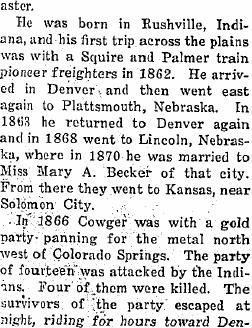
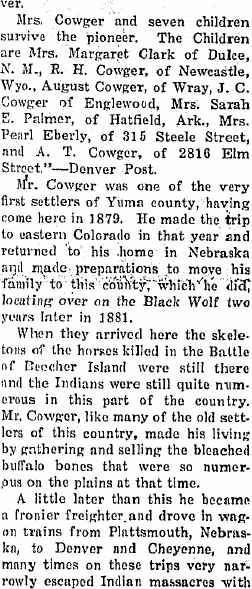
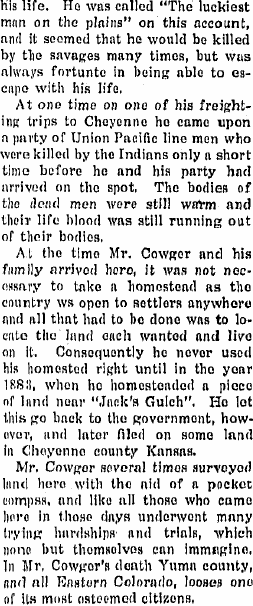
COWGER REUNION
August 13, 1933
At the home of Mr. & Mrs. John C. Cowger, Morrison, CO
Mrs. Mary A. Cowger - 2816 Elm St. Denver, CO.
Sarah E. (Cowger) Palmer - R#8 Oklahoma City, OK.
Addie Busboom - 2501 S. 13th St., Lincoln, NB
Mrs. Emma (Palmer) Crouch - Seminole, OK
Miss Edna Palmer - Seminole, OK
John C. & Alice May Cowger - Morrison, CO
Charles T. & Blanche Cowger - 2118 S. Bannock St., Denver, CO
Fern Cowger
Clarence D. Cowger
Charles Larry Cowger
Laurel Dawn Cowger
Monroe M. & Alice Mae Cowger - Morrison, CO
Merle J. & Alma L. Cowger - 72 Hazel Ct., Denver, CO
Norma Jean Cowger
John Edwin Cowger - Morrison, CO
Alonzo T. Cowger - Roseburg, OR
August Cowger - Pinedale, WY
Pearl L. (Cowger) Eberly - 466 Galapego St., Denver, CO
Marie Eberly
Joseph C. Steele - 2224 Stout St., Denver, CO
Mary P. Steele - 2224 Stout St., Denver, CO
Frank D.A. & Margaret (Cowger) Clark - 813 E. 14th St., Denver, CO
Pearl Luella May EBERLY -1882 - 1964 is buried in Mr. Olivet, Wheat Ridge.
Sarah E. Palmer married J. Glen Briggs Mar 14, 1918
Sarah Elizabeth Cowger Palmer is buried in Lincoln, Nebraska sec B, lot 225,
sp 1. First husband was Ulysses Grant Browning. Son of Lewis Dudley
Browning and Lucy A Herring born in 1869 in Kansas. Married Sarah Elizabeth
Cowger on 17 Nov 1892 in St. Francis, Cheyenne County, KS. They divorced in
1900. They had the following children:
Addie May Browning 1894 -1960
Dudley Cather Browning 1895 - ?
Addie May Browning Busboom is buried in Lincoln, next to Sarah.
California death index has Emma Palmer Johnson, born January 6, 1906 in Nebraska, dying Dec 29, 1988 in San Diego - mother's maiden name Cowger., and Edna Palmer Mason dying January 30, 1996 in San Diego, mother's maiden name Cowger.
I am looking for any information on John Cowger (1815-1886)
and 2nd wife Mary Sims Thomas descendants, they were married in Rush County,
IN., March 13, 1844.
From the census records I have followed them to Marion county Indiana 1850;
Dallas county, Iowa 1860; Polk county,Iowa 1870 can not find anything on Mary or
children
after 1870 census.
According the census records they had a total of 12 children, Martha P.(1845),
Aaron H.(1846), Elizabeth A.(1849),
Sarah M.(1850), Orman(1852), Eliza Jane(1855),
James C.(1857), Frank(1859), John(1863), Bell(1864),
Amos(1866), Joe(1868).
John Cowger died close to Hale, Colorado in the winter of 1886-1887, was buried
at Bonny, CO, then reburied at Armel, Colorado in 1949 when Bonny Dam was built.
Looking for any information on Mary and children....
| Birth: | 1815 Highland County Ohio, USA |
| Death: | 1886 Hale Yuma County Colorado, USA |
|
John's grave had to be moved to Armel Cemetery (Northeast of Hale, CO) in 1949, because the Bonny Lake & Dam was being constructed over the original gravesite. John's 1st wife was Elizabeth Ann (Caldwell) Cowger (1819-1842) married 1837, they had 2 children Margaret Ann Cowger(1838-????) & Thomas Cather Cowger(1840-1917) John's 2nd wife was Mary Sims (Thomas) Cowger (1824-1894) married 1844, they had 12 children. Family links: |
|
Back to Pioneer Photographs.
This page is maintained by M.D. Monk.